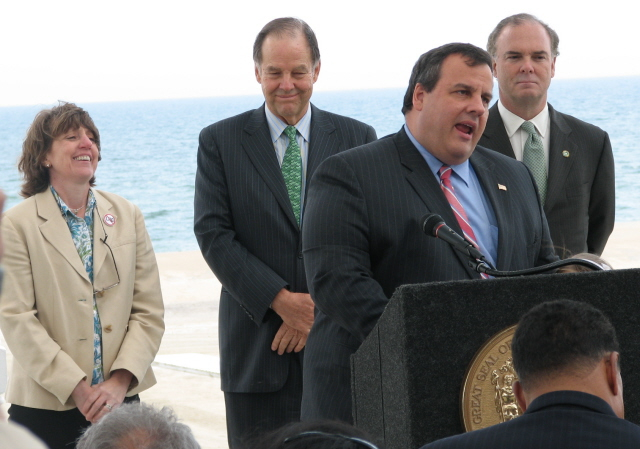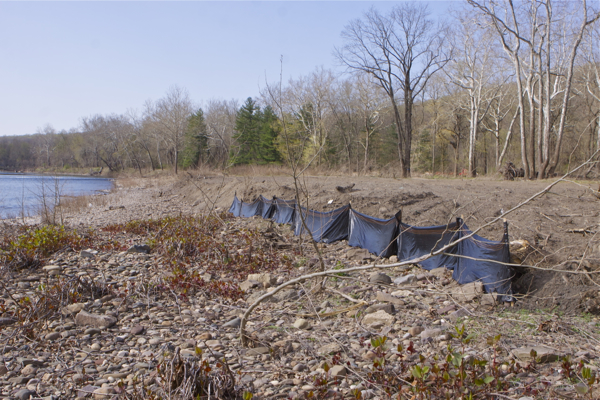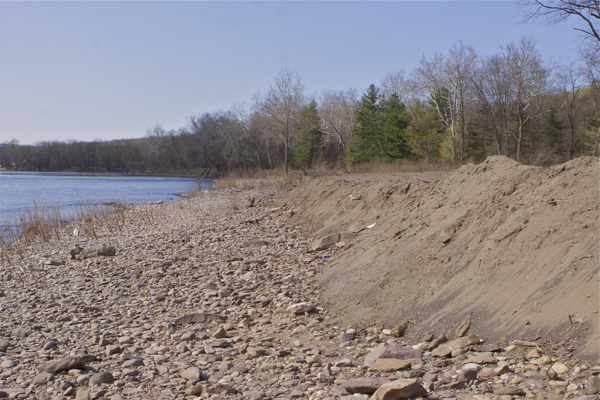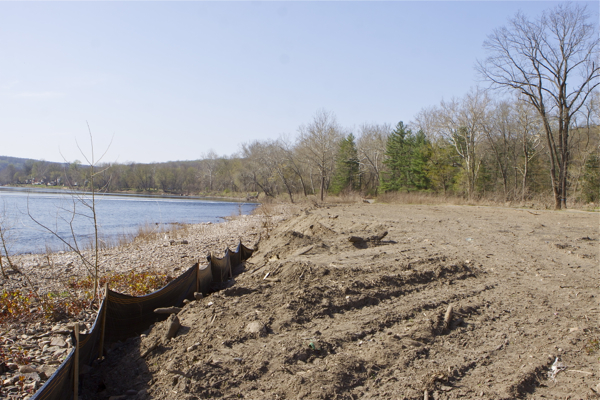25th Anniversary of Pequest Trout Hatchery Tainted by Waiver Rule
Healthy Trout Waters Threatened By DEP Regulatory Rollbacks
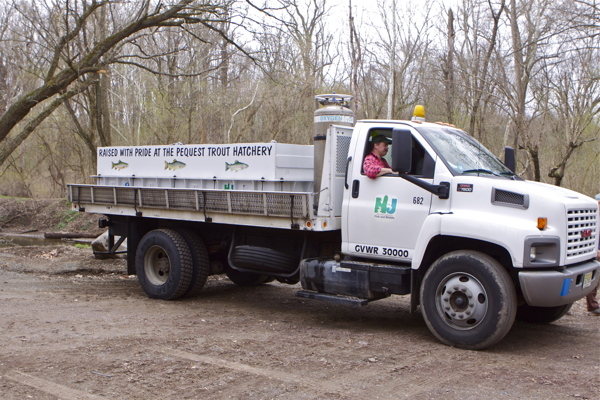
Pequest trout stocking – D&R Canal at Bulls Island
DEP issued another self serving press release to celebrate this weekend’s hosting of the Pequest’s 25th TROUT HATCHERY FREE OPEN HOUSE.
Listen to the typical overt politicization of DEP, the spin, and the hypocrisy of the message from DEP Commissioner Bob Martin:
“Opening day of the trout season is a revered spring tradition for families and outdoor enthusiasts alike,” said DEP Commissioner Bob Martin. “The Christie Administration understands and appreciates this tradition for thousands of New Jersey residents and visitors, as well as the need to protect the waters that support these prized fish.”
Bob Martin and the Christie Administration may appreciate the tradition, but they are doing nothing to preserve that tradition and instead are seriously jeopardizing that tradition by rolling back water quality and land use regulations designed to protect trout.
NJ’s trout streams receive special protections under a host of DEP regulatory programs.
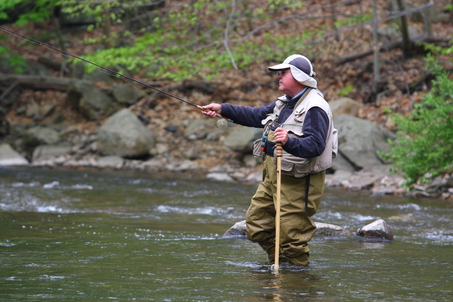
Additionally, many trout streams are located in the NJ Highlands region and are protected by the Highlands Master Plan, which is under attack by the Christie Administration and the Governor’s appointed minions on the Highlands Council.
But for today, instead of laying out the comprehensive nature of the threat, I’d like to focus on the most pressing threat to the health of trout waters, the DEP waiver rule.
Under the DEP waiver rule, the DEP Commissioner is granted extraordinary power to waive virtually any regulatory protection deemed by a permittee to be “unduly burdensome” or to conflict with other regulations. Additionally, permittees are given an opportunity to seek a waiver from any regulation if they can demonstrate that they can provide a “net environmental benefit”.
There are no technical definitions or scientific methods to apply “undue burden” or “net environmental benefit”.
Therefore, waiver decisions will be made on an ad hoc case-by-case basis, which means that they will not be governed by any consistent and scientifically based methodologies, criteria, standards, Guidance document, Technical Manual, or overall policy.
The vague nature and ad hoc practice of issuing waivers in the absence of science based methods invites abuse, increases uncertainty in permit decisions, reduces predictability and transparency, and will increase permit delays and backlogs.
Each DEP program and individual staffer writing permits will have their own perspective on how to waive requirements. Chaos will ensue as permit applicants forum shop.
Waiver reviews divert scarce DEP staff resources from the Agency’s core mission and undermine the public confidence in the integrity of the Department.
So, in addition to these severe management and policy problems, given the Pequest Trout Hatchery Open House celebration, we thought we’d provide a few illustrations of exactly how the DEP waiver rule would harm NJ’s sensitive high quality trout waters (wonks can hit the links below to read the rules).
Trout are a sensitive species that requires clean and cold water to survive.
Freshwater wetlands that drain to designated trout streams are classified as “exceptional value wetlands” and given 150 foot wide buffers. Those buffers filter water pollutants from the trout streams and provide vegetation that shades the stream and helps keep water temperatures down.
Under the waiver rule, a builder or other construction project could be provided relief from the buffers, allowing development to destroy those protective buffers.
II) Category 1 Stream 300 foot-wide Buffers
Streams that are able to sustain naturally reproducing trout are defined as “Trout Production” (TP) waters. TP steams are classified under DEP Surface Water Quality Standards as “Category One waters” (C1). C1 waters are afforded 300 foot wide stream buffers (on each side of the stream) as BMP’s under the storm water management and stream encroachment regulations.
These buffers limit development and are strongly opposed by land owners and builders.
Under the DEP waiver rule, builders will receive waivers from the 300 foot C1 buffers.
III) Stormwater Best Management Practices (BMP’s)
Stormwater from rainfall running off developed impervious surfaces carries pollutants to nearby streams and causes erosion. The resulting sediment and pollutant loads destroy trout streams.
DEP stormwater regulations require and encourage various stormwater BMPs, most importantly to recharge water on the site, protect water quality, and avoid or minimize erosion. By recharging storm water into the ground, nearby stream benefit as groundwater provides “base flow” during the hot summer and periods of low rainfall.
BMP’s cost money and can reduce development. Builders view them as “unduly burdensome” and they will seek and be issued waivers from DEP stormwater requirements and BMP’s. Trout will suffer.
Many development projects and other so called “point sources” (pollution discharge via pipe, sewage treatment or industrial sources, etc) are required by DEP to conduct stream studies to assess the impacts of their projects and mitigate impacts.
These studies cost money are are considered “unduly burdensome”. They will be waived and water quality will decline and trout will suffer.
DEP requires that many polluters monitor their pollution (compliance monitoring) and/or the ambient water quality nearby. This information is vital to setting protective permit conditions and enforcing them.
But monitoring costs money and is considered “unduly burdensome”. Waive it goodbye.
VI) Increases on Wastewater Flows or Pollutant Loads
DEP policy is to prevent degradation of high quality waters. The presence of high quality trout waters results in limits on the total capacity (wastewater flows and pollutant loads) that may be allocated to regional sewage treatment plants.
In turn, these limits on capacity restrict the amount of development that may occur in the watershed.
As such, the local sewer authorities view them as”unduly burdensome” limits on their operating revenues and the builders view them as limits of development.
A good example is the Sussex County Municipal Utilities Authority plant which discharges to the Walkill river near the National Wildlife Refuge. The capacity of the plant is limited, which limits development in this environmentally sensitive watershed.
Kiss those limits goodbye – they unduly burden development.
VII) Water Releases to Maintain Minimum Stream Flows and Temperatures
Trout require cold flowing streams. Some of these stream are protected by DEP set minimum stream flow and temperature requirements. DEP requires some permittees to release water to meet these minimum flow or temperatures to protect trout.
Releases from the Newark reservoirs to the Pequannock River are a good example – but this costs money and is viewed as unduly burdensome. Waive those protections goodbye.
VIII) Water Allocation Permits
DEP issues permits to pump groundwater or divert streams or rivers for water supply.
One of the factors DEP considers in deciding how much water that can be diverted to water supply  in an environmentally sound way is impacts on the flows of streams. Trout streams are given special consideration.
Water allocation permit applicants are required to conduct costly studies to assess these kinds of impacts.
Builders, landowners, business and economic development interests view DEP studies and permit conditions as limits on available water as undue burdens on economic growth and development.
Permit conditions and studies DEP require permittees to conduct support needed revisions of:
- Safe Yields and Minimum Passing Flows in light of new hydrological data, including revisions to the NJ Geological Survey Technical Memorandum “The Hydrological Integrity Assessment Process in New Jersey”;
- Revisions of Safe Yields and Minimum Passing Flows to address Ecological Flow Goal protections and cumulative impact methodology, including new restrictions on hydro-modification of wetlands systems and alteration of stream base flow, as illustrated by the Berlin Boro well case NJ Geological Survey GSR 29 “GUIDELINES FOR PREPARING HYDROGEOLOGIC REPORTS FOR WATER-ALLOCATION PERMIT APPLICATIONS”; and
- Establishing Cumulative impact thresholds and ecological standards for allowable withdrawals in groundwater dependent areas, in consideration of currently unregulated withdrawals (see this historical classic);
DEP issues permits to developments of over 50 units the rely on septic systems.
Nearby trout streams are given buffers and other protections that limit the location, design, and size of the septic system, and thereby limit development potential.
Landowners and developers see the costly DEP mandated studies and permit restrictions as “unduly burdensome” limits on development. Bye-bye.
X) Watershed Studies – Water Quality Management Planning
DEP water quality management planing rules – which dictate where sewers are located and how much wastewater treatment capacity is assigned to a regional sewage treatment plant – dramatically impact land use and economic development.
The WQMP rules require numerous planning, mapping, and scientific studies related to land use and water quality. These studies cost money and the rules limit development.
Builders, landowners, public authorities, and county governments view these rules as excessively prescriptive and unduly burdensome.
Gone.
DEP Highlands regulations set forth comprehencie requirements to protect critcial Highlands waters and natural resources, including a restrictive 88 acre minimum lot size (septic density) in the preservation area.
These regulatory restrictions are strongly opposed by land owners and builders as “unduly burdensome”.
Trout streams benefit from these protections. All of them can be waived.
XII) Net Environmental Benefit Abuse
Given the mitigation, land swaps, and pollutant trading schemes that are already approved by DEP, I can’t even begin to imagine the kinds of abuse that this will invite.
Incommensurables – apples – oranges – grapes – the sky is the limit.
Land for water – water for wildlife – air quality, energy, recycling and a multitude of other “good deeds” will be used to relax various regulatory requirements.
Just use your imagination- and then ask Bob Martin: Let’s Make a Deal!
(Or Call Lt. Gov. Guadagno and ask for a little “customer service“!)
(Or, you could always talk to Cindy or Dave – they have friends in High Places:
